#supernovae
Text
Supernova 1987A's Rings of Power

Here's a Hubble photo - that's the supernova remnant embedded in the center of the image.

A Hubble close-up.
Now the Webb Space Telescope crew has released a new photo, bringing out incredible detail using the instrument's infrared camera:
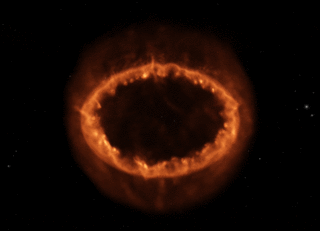
The center of the remnant is packed with clumpy gas and dust ejected by the supernova explosion, first seen lighting up the Large Magellanic Cloud in February, 1987. The dust is so dense that even the near-infrared light Webb can detect can't penetrate, shaping the dark spot at the center of what looks like a keyhole.
A bright, equatorial ring surrounds all this, forming a band around the waist from material ejected tens of thousands of years before the supernova explosion. This ring contains bright hot spots that appeared as the supernova's shock wave hit the ring. Two faint arms of hourglass-shaped outer rings surround it.
Webb reveals spots throughout the ring, where supernova shocks crash into exterior material:

We'll close with NASA's animated model of Supernova 1987A's Ring of Power.
Imagine what it would be like to live on an alien world in the Large Magellanic Cloud when this beautiful monster popped off just down the street, briefly brighter than all the other stars in this companion galaxy - even brighter than our huge Milky Way Galaxy, the huge city right next door. Our potential alien neighbor can probably still see the glowing remnant in the night sky with naked eyes, decades after the star's brilliant demise. But when it exploded, it would have been visible there in broad daylight.
66 notes
·
View notes
Text

#space#cosmos#universe#astronomy#astrophotography#astrospace#spaceexploration#stars#planets#galaxies#nebulae#blackholes#supernovae#cosmicdust#spacejunk#alienlife#intergalactic#extraterrestrial#celestial#astronomical#spacecraft#satellites#rockets#spacetelescopes#spaceprograms#spacehistory#spacetravel#spacemissions#astronauts#cosmonauts
31 notes
·
View notes
Text
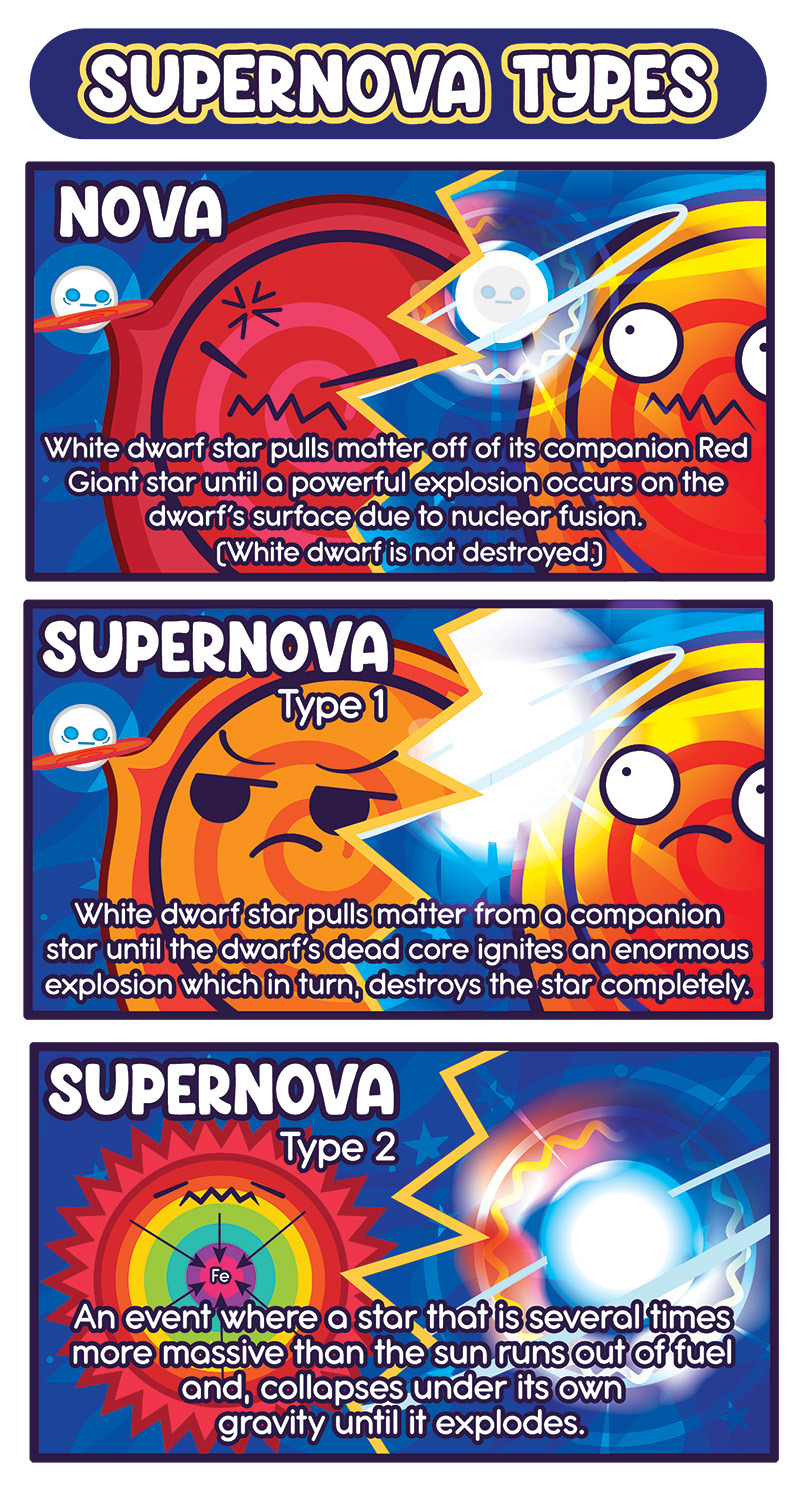
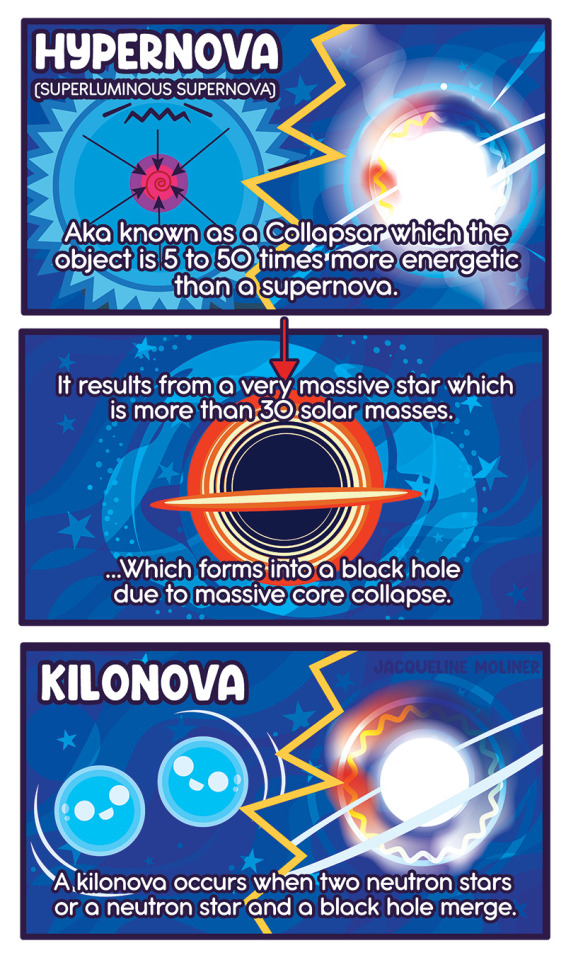
Let’s finish July with a bang! Today’s comic: Supernova types!
https://www.space.com/31608-supernovas-star-explosions-infographic.html
#cosmic funnies#astronomy#space#cute#science#kawaii#reblog#blog update#stars#educational#summer#hot#supernovae#supernova#black holes
555 notes
·
View notes
Text
New Discovery released on July 5, 2023 by James Webb Telescope Confirms Supernovae as Dust Factories

Researchers using NASA's James Webb Space Telescope have made a groundbreaking confirmation of the role supernovae play in supplying dust to the early universe. Discover the significant findings and implications of their study. Astronomers have long pondered over the origin of cosmic dust, a crucial building block for celestial bodies like planets. The James Webb Space Telescope, operated by NASA, has recently provided groundbreaking insights into this enigmatic phenomenon. Observations of two Type II supernovae, Supernova 2004et (SN 2004et) and Supernova 2017eaw (SN 2017eaw), have shed light on the substantial amounts of dust present within their ejecta. Read full article here.
19 notes
·
View notes
Text
Wolf-Rayet star 124 and its nebula
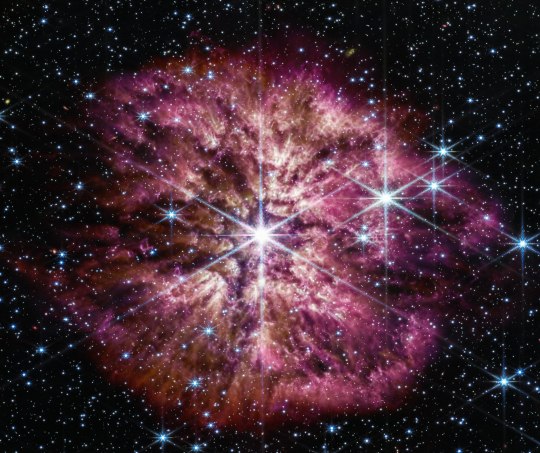
Wolf-Rayet stars are among the most luminous and massive - and rarest to see, because they live such brief lives. this photo by NASA’s Webb Space Telescope reveals unprecedented details around the star WR 124, such as the 100-billion-mile-wide glowing gas blobs it's ejecting at faster than 100,000 mph
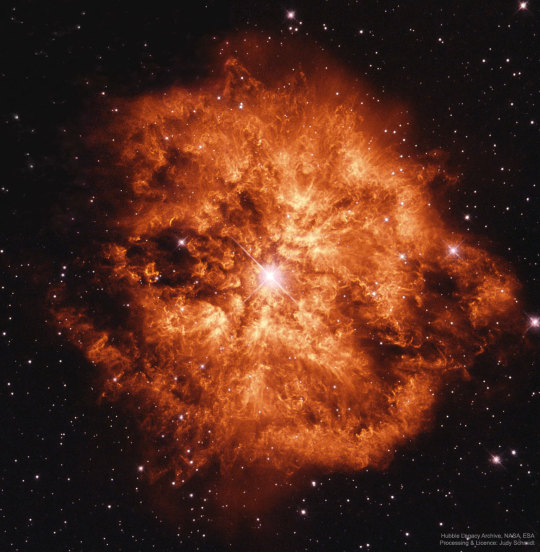
(older photo by the Hubble Space Telescope)
Wolf-Rayet stars are in the process of casting off their outer layers, resulting in their characteristic halos of gas and dust. WR 124 is 30 times the mass of our Sun and has shed 10 Suns’ worth of material so far, with much more to come before it explodes in a supernova explosion
supermassive stars race through their lifecycles, and only some of them go through a brief Wolf-Rayet phase before going supernova, making Webb’s detailed observations of this rare phase invaluable - such cast-off material later gathers to form planets and new stars, and serves as a platform for molecules to form and clump together, including the building blocks of life
44 notes
·
View notes
Text

Nebulae,Supernovae & Stars Captured by Hubble Space Telescope.
25 notes
·
View notes
Text
" ибо я не надеюсь вернуться... "
supernovae_dfg x 2021 x printed in blood x Unreleased




#hannibal#supernovae dfg#red#hannigram#will graham#supernovae_dfg#colours in the dark#supernovae#hannibal deserves more#unreleased
91 notes
·
View notes
Photo
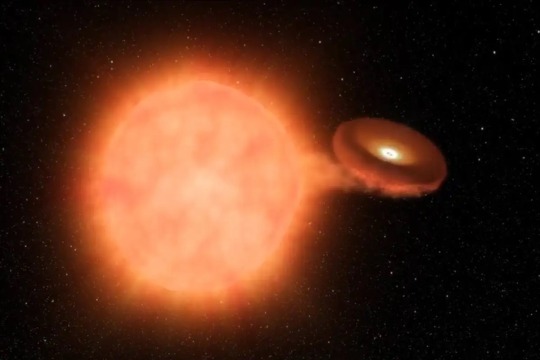
Fastest star in the galaxy clocked at 2285 kilometres per second
Astronomers have spotted white dwarfs moving faster than any free-moving star seen before – so fast they must have been launched by supernovae
The white dwarf on the right is stealing matter from a neighbouring star. It will eventually explode as a type Ia supernova, propelling its companion away
NASA/JPL-Caltech
#art#photography#cosmos#cosmic#galaxy#astronomy#universe#surreal#nasa#JPL-caltech#dwarf#supernovae#star#blast
19 notes
·
View notes
Video
⚠️Sound on 🔊
Hubble image of the Helix Nebula converted to sound.
Via nowspacetime
#space#hubble#Helix Nebula#nebulae#galaxy#Galaxies#planet#planets#stars#supernovae#clouds#dust#SolarSystem#univers#cosmos#cosmology#explore#discover
70 notes
·
View notes
Text
"Neutrinos created in exploding stars [charging/discharging?] could point to physics beyond the Standard Model, according to calculations done by Po-Wen Chang and colleagues at Ohio State University in the US. Their work explains how a hypothetical interaction affects the pulse of neutrinos that is generated in a core-collapse supernova – something that could be seen in existing and future observations of supernovae.
Neutrinos are low-mass and electrically neutral subatomic particles that can travel long distances through matter without interacting. They are produced in vast quantities by some astrophysical processes and astronomers use huge detectors to study the neutrinos that arrive on Earth. As well as telling us something about astrophysics, studying these cosmic neutrinos can provide insights into the nature of the particles themselves.
Now, Chang’s team has explored the possibility that supernovae explosions could trigger neutrino behaviours that cannot be explained by the Standard Model of particle physics.
The Standard Model says that neutrinos interact with each other via the weak nuclear force or gravity. But during core-collapse supernovae, the particles are expected to become so densely packed that they scatter off each other far more frequently than usual. In such extreme conditions, some theories that go beyond the Standard Model suggest that a hypothetical interaction called “enhanced self-interaction” (νSI), could emerge. This interaction is predicted to be orders of magnitude stronger than the weak interaction and should therefore affect the behaviour of neutrinos in such supernovae."
continue article
#physics#neutrinos#stars#cosmology#astronomy#universe#space#energy#matter#plasma#electricity#magnetism#electromagnetism#astrophysics#plasma physics#interaction#micronovae#supernovae#science
2 notes
·
View notes
Text

#space#cosmos#universe#astronomy#astrophotography#astrospace#spaceexploration#stars#planets#galaxies#nebulae#blackholes#supernovae#cosmicdust#spacejunk#alienlife#intergalactic#extraterrestrial#celestial#astronomical#spacecraft#satellites#rockets#spacetelescopes#spaceprograms#spacehistory#spacetravel#spacemissions#astronauts#cosmonauts
31 notes
·
View notes
Text

An article published in the journal "Monthly Notices of the Royal Astronomical Society" reports the identification of large amounts of dust from two supernovae in the galaxy NGC 6946. A team of researchers used the James Webb Space Telescope to find traces of dust coming from the supernovae SN 2004et and SN 2017eaw exploiting in particular the potential of the MIRI instrument. The result is the discovery of large amounts of dust among the material ejected from each of the two supernovae and this supports the theory that in the early universe, supernovae played a key role in producing dust.
3 notes
·
View notes
Photo
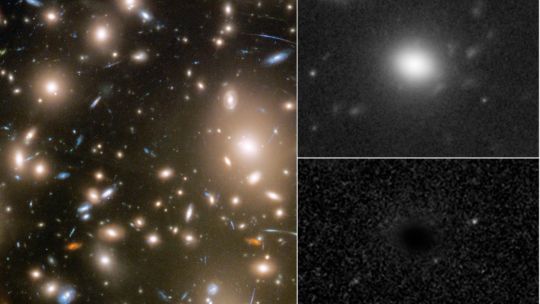
Right place, right time: Hubble captured a supernova as it exploded | Space
... Inputting the Hubble data into models and analyzing details in the images like brightness and color, Chen and his team determined that the original star that had gone supernova was likely a red supergiant with a diameter approximately 530 times that of the sun.
They also determined that the first image in the series of three was taken by Hubble just six hours after the explosion following the core collapse, with the second and third being taken about 10 and 30 days after the explosion, respectively. ...
Visit the webpage & watch the video - it’s mindblowing!
9 notes
·
View notes
Text
Supernova Remnant G1.9+0.3

image by NASA's Chandra X-Ray Observatory et al
25,000 light-years away in the constellation Sagittarius, a star went supernova, violently exploding to create remnant G1.9+0.3
although the star died long ago, its light reached Earth just about 110 years ago, making it the youngest known supernova remnant in the Milky Way Galaxy
G1.9+0.3's cast-off outer shells contain the most energetic electrons ever observed in a supernova remnant, and they're expanding outward at an unprecedented 35 million miles (56 million kilometers) per hour - about 5% the speed of light
8 notes
·
View notes
Text


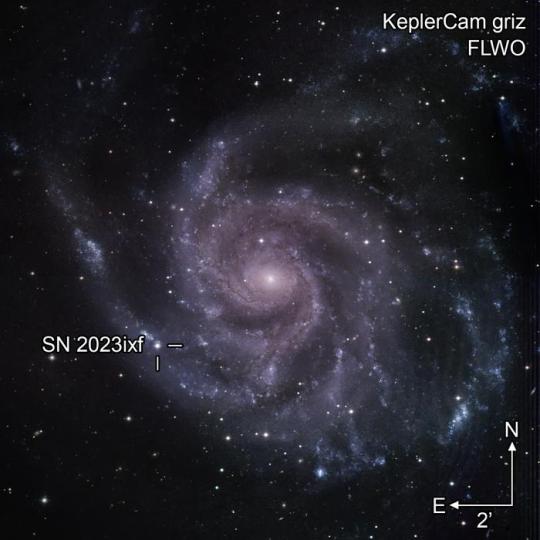
Extreme weight loss: Star sheds unexpected amounts of mass just before going supernova
A newly discovered nearby supernova whose star ejected up to a full solar mass of material in the year prior to its explosion is challenging the standard theory of stellar evolution. The new observations are giving astronomers insight into what happens in the final year prior to a star’s death and explosion.
SN 2023ixf is a new Type II supernova discovered in May 2023 by amateur astronomer Kōichi Itagaki of Yamagata, Japan shortly after its progenitor, or origin star, exploded. Located about 20 million light-years away in the Pinwheel Galaxy, SN 2023ixf’s proximity to Earth, the supernova’s extreme brightness, and its young age make it a treasure trove of observable data for scientists studying the death of massive stars in supernova explosions.
Type II or core-collapse supernovae occur when red supergiant stars at least eight times, and up to about 25 times the mass of the Sun, collapse under their own weight and explode. While SN 2023ixf fit the Type II description, followup multi-wavelength observations led by astronomers at the Center for Astrophysics | Harvard & Smithsonian (CfA), and using a wide range of CfA’s telescopes, have revealed new and unexpected behavior.
Within hours of going supernova, core-collapse supernovae produce a flash of light that occurs when the shock wave from the explosion reaches the outer edge of the star. SN 2023ixf, however, produced a light curve that didn’t seem to fit this expected behavior. To better understand SN 2023ixf’s shock breakout, a team of scientists led by CfA postdoctoral fellow Daichi Hiramatsu analyzed data from the 1.5m Tillinghast Telescope, 1.2m telescope, and MMT at the Fred Lawrence Whipple Observatory, a CfA facility located in Arizona, as well as data from the Global Supernova Project— a key project of the Las Cumbres Observatory, NASA’s Neil Gehrels Swift Observatory, and many others. This multi-wavelength study, which was published this week in The Astrophysical Journal Letters, revealed that, in sharp contradiction to expectations and stellar evolution theory, SN 2023ixf’s shock breakout was delayed by several days.
“The delayed shock breakout is direct evidence for the presence of dense material from recent mass loss,” said Hiramatsu, adding that such extreme mass loss is atypical of Type II supernovae. “Our new observations revealed a significant and unexpected amount of mass loss— close to the mass of the Sun— in the final year prior to explosion.”
SN 2023ixf challenges astronomers’ understanding of the evolution of massive stars and the supernovae they become. Although scientists know that core-collapse supernovae are primary origin points for the cosmic formation and evolution of atoms, neutron stars, and black holes, very little is known about the years leading up to stellar explosions. The new observations point to potential instability in the final years of a star’s life, resulting in extreme mass loss. This could be related to the final stages of nuclear burn-off of high-mass elements, like silicon, in the star’s core.
In conjunction with multi-wavelength observations led by Hiramatsu, Edo Berger, professor of astronomy at Harvard and CfA, and Hiramatsu’s advisor, conducted millimeter-wave observations of the supernova using CfA’s Submillimeter Array (SMA) on the summit of Maunakea, Hawai'i. These data, which are published in The Astrophysical Journal Letters, directly tracked the collision between the supernova debris and the dense material lost before the explosion. “SN 2023ixf exploded exactly at the right time,” said Berger. “Only a few days earlier we commenced a new ambitious three-year program to study supernova explosions with the SMA, and this nearby exciting supernova was our first target.”
“The only way to understand how massive stars behave in the final years of their lives up to the point of explosion is to discover supernovae when they are very young, and preferably nearby, and then to study them across multiple wavelengths,” said Berger. ”Using both optical and millimeter telescopes we effectively turned SN 2023ixf into a time machine to reconstruct what its progenitor star was doing up to the moment of its death.”
The supernova discovery itself, and the immediate followup, have significant meaning to astronomers around the world, including those doing science in their own backyards. Itagaki discovered the supernova on May 19, 2023, from his private observatory in Okayama, Japan. Combined data from Itagaki and other amateur astronomers determined the time of the explosion to an accuracy of within two hours, giving professional astronomers at CfA and other observatories a head start in their investigations. CfA astronomers have continued to collaborate with Itagaki on on-going optical observations.
“The partnership between amateur and professional astronomers has a long-standing tradition of success in the supernova field,” said Hiramatsu. “In the case of SN 2023ixf, I received an urgent email from Kōichi Itagaki as soon as he discovered SN 2023ixf. Without this relationship, and Itagaki’s work and dedication, we would have missed the opportunity to gain critical understanding of the evolution of massive stars and their supernova explosions.”
TOP IMAGE.... In the year prior to going supernova the red supergiant star now known as SN 2023ixf shed an unexpected amount of mass equivalent to the mass of the Sun. This artist’s conception illustrates what the final stages of mass loss might have looked like before the star exploded. CREDIT Melissa Weiss/CfA
CENTRE IMAGE....One of the nearest Type II supernovae in a decade and among the brightest to date, SN 2023ixf is a young supernova, discovered earlier this year by amateur astronomer Kōichi Itagaki of Yamagata, Japan. This artist’s conception shows the bright explosion of SN 2023ixf, which occurred after an unexpected amount of mass loss unlike anything astronomers have seen before. CREDIT Melissa Weiss/CfA
LOWER IMAGE....Captured using the 1.2m telescope at CfA’s Fred Lawrence Whipple Observatory on June 27, 2023, just over a month after SN 2023ixf’s progenitor star exploded, the image in this composite combines together green, red, near-infrared, and infrared light to highlight both SN 2023ixf and the Pinwheel Galaxy. SN 2023ixf is located in one of the spiral arms of the galaxy, as expected for the explosions of massive stars. CREDIT S. Gomez/STScI
2 notes
·
View notes
Text
"My heart circles yours like planets circling the sun, a meteor shower of love blows through your heart like cosmic winds, and I explode inside like a supernova of grins.."
The way I love you is almost cosmic - eUë
#planets#stars circling my heart#meteor shower#shower of love#in your heart#galaxies in your heart#cosmic winds#cosmic#supernova of grins#supernova#supernovae#universe#i love you#make me smile#i like you#poetry#poem#poetic#twcpoetry#spilled ink#spilled thoughts#spilled words#love quotes#love#love quote life quotes#love quote for her#quoteoftheday#romance#romantic#falling in love
14 notes
·
View notes